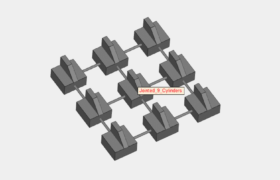An STL file typically represents a single, three-dimensional object.

If your design contains multiple separate parts, each part should be contained in its own individual STL file. For example:

A “multi-part STL” is a single STL file that contains the data for multiple distinct parts. This can occur whether the parts are designed to be connected, or simply exist in the same file. Here are some examples:


You might have considered uploading multi-part STLs to reduce costs, or simply for convenience. However, we strongly advise against this.
Uploading multi-part STLs will NOT save you money. In fact, it can often increase the overall cost of your order. Here’s why:
- Increased Handling Fees: Processing multi-part STLs requires more manual labor from our technicians. Separating the parts, orienting them for optimal printing, and ensuring correct quantities all add to handling time and cost.
- Increased Support Material: Multi-part STLs, especially those with interconnected parts, can lead to increased support material generation during the printing process. More support material means higher material usage and longer post-processing times for support removal, both of which contribute to cost.
- Per-Part Charges: Even if the parts are contained within a single STL file, our system and technicians will treat them as separate parts. You will be charged on a per-part basis, and this may be applied during a manual review, leading to a second payment request.
- Potential for Errors: Uploading multi-part STLs can increase the risk of errors during the quoting and manufacturing process. This can lead to delays, quality issues, and the need for rework, all of which can increase costs.
To avoid potential delays, additional charges, and ensure a smooth process, please submit each individual part of your design as a separate STL file. This will streamline the quoting and manufacturing process, and help us deliver your parts accurately and efficiently.
